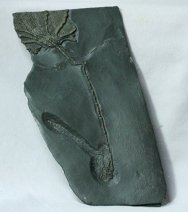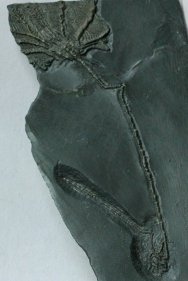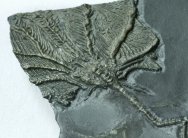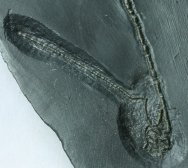Imitatocrinus
gravilior
Phylum Echinodermata,
Class Crinoidea, Subclass Cladida, Family Botryocrinidae
Geological
Time:
Lower Devonian,
Seigenian/Emsian Stage
Size (25.4
mm = 1 inch): Crown: 50 mm across by 30 mm high Stem: 125 mm long
(plus holdfast) Second stem: 65 mm long on a 180 by 95 mm matrix
Fossil
Site: Hunsruck Slate, Bundenbach Germany
Code: B010
Price: Sold
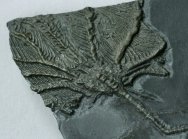 Description:
Well-preserved example of a cladid crinoid of the Family Botryocrinidae
known as Imitatocrinus gravilior. The Hunsruck slate is famous
for its fossils, many of which have pyritization present. Rapid
burial and pyritization was what led to the many wonderful examples
of early Devonian life from the region. The chemistry of the silt
was such that low organic content and high levels of iron and sulfur
allowed the pyrite to diffuse into the tissues rather than be deposited
in the sediment. The pyritization of this one is evident, making
for an esthetic display piece. The mudstones were metamorphosed
into slate during the Carboniferous. The slate was quarried for
roofing tiles, and the quarrymen would save the fossils for later
sale. Now that the quarries are no longer open, future supplies
of these wonderfully-preserved benthic organisms will only come
from existing collections. This is a well-articulated specimen
which dominates its large slate plaque. The calyx is nearly complete
while the stem articulates to its holdfast. Lastly, there is a
a second smaller stem present. Description:
Well-preserved example of a cladid crinoid of the Family Botryocrinidae
known as Imitatocrinus gravilior. The Hunsruck slate is famous
for its fossils, many of which have pyritization present. Rapid
burial and pyritization was what led to the many wonderful examples
of early Devonian life from the region. The chemistry of the silt
was such that low organic content and high levels of iron and sulfur
allowed the pyrite to diffuse into the tissues rather than be deposited
in the sediment. The pyritization of this one is evident, making
for an esthetic display piece. The mudstones were metamorphosed
into slate during the Carboniferous. The slate was quarried for
roofing tiles, and the quarrymen would save the fossils for later
sale. Now that the quarries are no longer open, future supplies
of these wonderfully-preserved benthic organisms will only come
from existing collections. This is a well-articulated specimen
which dominates its large slate plaque. The calyx is nearly complete
while the stem articulates to its holdfast. Lastly, there is a
a second smaller stem present. |
|

